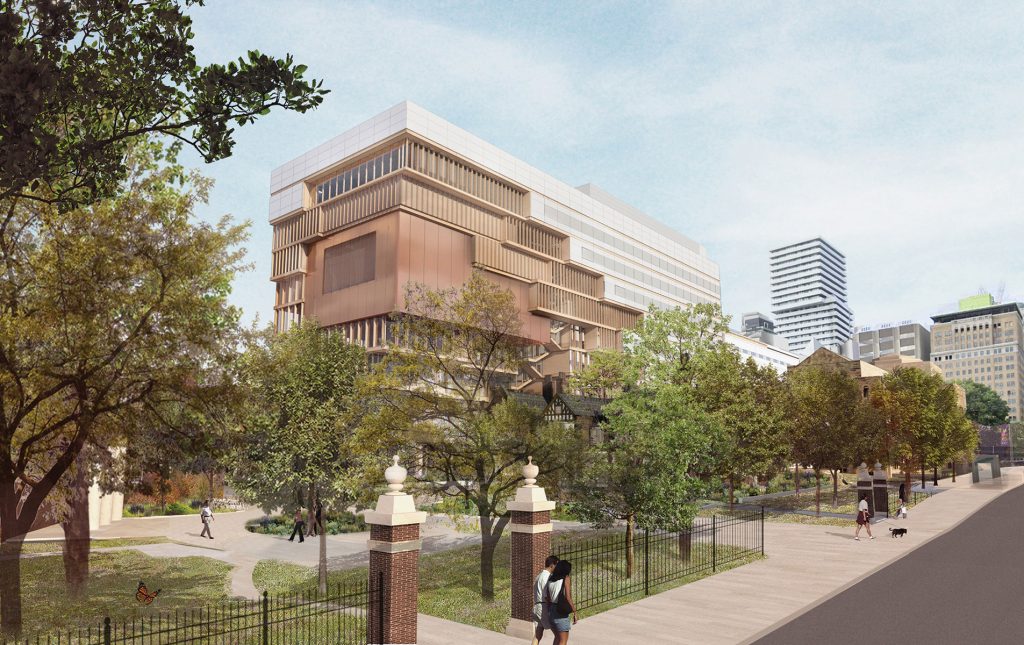New plans fail to quell concerns

By Tanya Ielyseieva
A re-vamped proposal with a scaled-down building on the site of the former McLaughlin Planetarium continues to face opposition from community groups representing local residents. A July 14 meeting was held to review the latest plans, and there, the Queen’s Park Coalition, which represents roughly 40,000 households, stated their case against the nine-story, multi-use building which they say will create an unacceptable visual impact on Queen’s Park and Philosopher’s Walk.
Designed by architects Diller Scofidio + Renfro, the proposed building will provide space for several academic departments including the Faculty of Arts and Science, the Faculty of Music, and the Faculty of Law. The development will include a recital hall, work areas, laboratories, meeting rooms, offices, and a café.
The initial consultation in June 2019 led to numerous changes in the size of the building, such as reducing the mass of the recital hall, initially conceived as a floating component that would have loomed over the stories below.
“Through this process, we have actually been able to push the recital hall further away. It still has a very sculptural presence and is elevated above Faulkner Hall with great views of the skyline, but it is enveloped by a set of overlapping adjacent window systems,” said Charles Renfro, Diller Scofidio + Renfro partner and architect. “The colour palette that we’ve chosen, not exactly the specific materials, but our palette is warm and friendly and takes cues from brick and limestone, and in the facade, you can see powder-coated aluminum, which takes a sort of brick colour.”
The updated proposal will be 43 metres and includes a mechanical penthouse, which exceeds the 18-23 metre height permission in the area.
The July 14 consultation was held to assess these revisions. Members of the Queen’s Park Coalition stated that the proposal continues to show a lack of concern for the cohesive landscape and built form of the area and fails to resolve two fundamental issues:?bulk and height.
“There’s just too much program on a too-small site hemmed in by lovely heritage buildings on three sides,” said Bronwyn Krog, a representative of the Queen’s Park Coalition. “With the front and back highly visible from two important heritage landscapes, Queen’s Park and Philosopher’s Walk. The proposal will create an unacceptable visual impact on these heritage cultural landscapes, which are a fundamental planning principle.”
Krog read a letter from Bill Greer, the architect for the Toronto Historical Board.
“The proposed structure is too high, too bulky, and an entirely inappropriate gold colour for this district. It does not fit within the heritage context of the significant historic area of the St. George campus of the university. It is also critically important to preserve all of the mature trees on the site as it will take many generations before new trees grow to an equivalent size,” reads the letter.
Sue Dexter, of the Harbord Village Residents’ Association, stressed that these are not planning issues but “living issues” which intersect with the heritage context and will be overwhelmed by the present proposal policy.
“Before approving this application, we need to get the heritage right. We all have a responsibility to generate policies for the site that reflect community priorities, conserve character, and allow for compatible development to occur. The university has 16 available sites for buildings from the 1997 master plan. There is no excuse to overbuild here and lose a heritage landscape prized by the residents of this city,” said Dexter.
According to Dan DiBartolo, Senior Planner at Heritage Preservation Services, all aspects from the demolition of the planetarium to the implementation of the landscape plan and the conservation of Faulkner Hall were looked at thoroughly.
The application is under review and the final report is set to be ready in the fall.
An anonymous spokesperson from the U of T stated, in an email to The Gleaner, that the hope is for approval to be forthcoming and for construction to begin in the spring of 2021.
“We are looking forward to creating a landmark building that will add to the city’s cultural district and offer new opportunities for public programs,” wrote the spokesperson. “We want this to be a building where the university connects with the city, and the city connects with us.”
READ MORE:
- NEWS: Cities trump space (May 2019)
- NEWS: U of T seeks to expand planning exemption (APRIL 2017)
- NEWS: New chapter for student residence? (February 2017)
- NEWS: Preventing a wall of towers (October 2016)
- CHATTER: Two new rezoning applications submitted to city (September 2016)
- NEWS: Tall tower before OMB, as city battles back with block study (August 2016)
- NEWS: Planning for the future (May 2016)
- DEVELOPINGS: Annual review reflects tension between community activism and OMB (March 2016)
